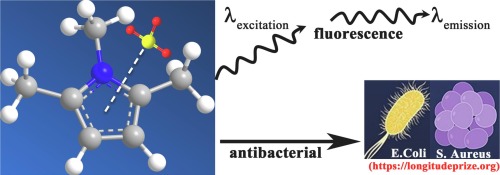Polymer ( IF 4.1 ) Pub Date : 2020-01-16 , DOI: 10.1016/j.polymer.2020.122188 Hatice Ozkazanc , Merve Menkuer , Ozcan Gundogdu , Ersel Ozkazanc

|
This study reports structural, charge transport and antibacterial properties of Poly(N-methylpyrrole) (PNMPy) and its composites. Optical studies indicated that both indium(III) oxide (In2O3) and tungsten(VI) oxide (WO3) nanoparticles increased the optical band gap of PNMPy. Furthermore, it was determined that the filling process increased the fluorescence quantum yield of PNMPy from 0.19 to 0.23 and 0.32 for PNMPy/In2O3 and PNMPy/WO3 composites, respectively. Two different frequency regions were observed for the conductivity in the temperature dependent dielectric analysis. Alternating conductivity analysis indicated that the dominant mechanism for the charge transport was the hopping type and the most suitable model was the correlated barrier hopping (CBH) model for PNMPy and its composites. While, In2O3 nanoparticles increased the hopping distance as well as the activation energy required for the hopping of the charge carriers in the polymer matrix, in contrast, WO3 nanoparticles decreased them. Both nanoparticles improved the thermal stability and antibacterial activity of the polymer matrix. PNMPy/In2O3 and PNMPy/WO3 semiconductor composites could be used not only in electronics and optoelectronics applications in the mid-frequency range but also in biomedical applications as they have also exhibited excellent antibacterial properties.
中文翻译:

多功能聚(N-甲基吡咯)/纳米氧化物复合材料:光电,电荷传输和抗菌性能
这项研究报告了聚(N-甲基吡咯)(PNMPy)及其复合材料的结构,电荷传输和抗菌性能。光学研究表明,氧化铟(III)(In 2 O 3)和氧化钨(VI)(WO 3)纳米颗粒均增加了PNMPy的光学带隙。此外,已确定填充过程将PNMPy / In 2 O 3和PNMPy / WO 3的PNMPy的荧光量子产率从0.19增加到0.23和0.32。复合材料。在取决于温度的介电分析中观察到两个不同的频率区域的电导率。交替电导率分析表明,电荷传输的主要机理是跳跃型,而最合适的模型是PNMPy及其复合材料的相关势垒跳跃(CBH)模型。虽然,In 2 O 3纳米颗粒增加了跳跃距离以及聚合物基质中电荷载流子跳跃所需的活化能,但与此相反,WO 3纳米颗粒却减少了跳跃距离。两种纳米颗粒均改善了聚合物基质的热稳定性和抗菌活性。PNMPy / In 2 O 3和PNMPy / WO 3 半导体复合材料不仅可以在中频范围的电子和光电应用中使用,还可以在生物医学应用中使用,因为它们还具有出色的抗菌性能。











































 京公网安备 11010802027423号
京公网安备 11010802027423号